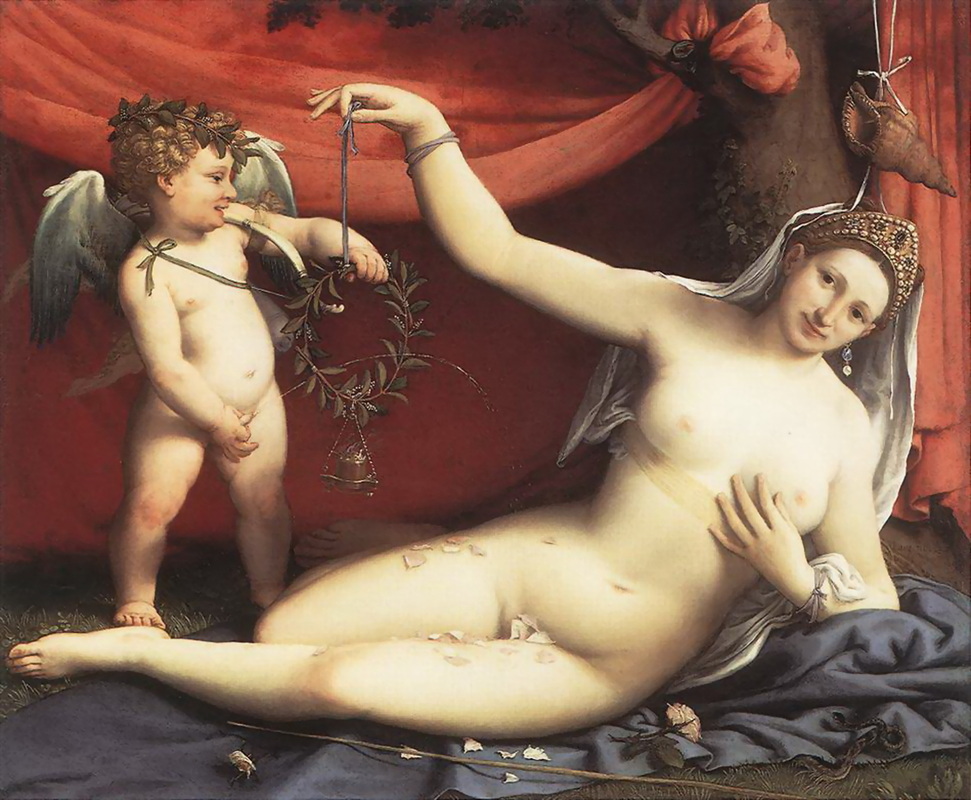Cultural COntexts
|
While we have explored the formal definitions of beauty and ugliness, we also need to explore how they manifest themsleves in reality. The idea that 'beauty is in the eye of the beholder' has been referenced so many times it has become a cliche. Yet there does appear to be ideas of what constitutes beauty, and its flip-side - ugliness, that have been consistent throughout all cultures and societies. So who, or what then, dictates what we consider visually pleasing or not?
Often what we consider aesthetically pleasing can be culturally specific. Notions of what defines beauty, or the lack of, are continually changing and take cues from the dominant ideology of the time. Take for example Lorenzo Lotto’s late 1520’s painting ‘Venus and Cupid’. We find Venus, the roman goddess of love, lying back in all her voluptuous splendor. By modern standards, she would be considered unusually plump for an icon of female beauty, with her slight stomach and soft, rolling curves. This is by no means an isolated incident, and many women in renaissance art would be considered ‘fat’ by today’s standards. If we are to truly understand an artist’s intention, and to read the messages and meaning of the artwork effectively we need to address the cultural context of the work. In fact, being slightly overweight in renaissance times, a time when many struggled to feed themselves at all, denoted wealth, and in turn desirability, and this is reflected in Venus's figure. We can compare these idealised images of the female form with their modern day counterparts, such as a Victoria's Secret models, and see how clearly the dominant cultural ideas of the time affect our changing notions of aesthetics and beauty. |
The famous philosopher Voltaire summed up the importance of culture in determining beauty and ugliness with the following:
"Ask a toad what beauty is... He will answer you that it is his toad wife with two great round eyes issuing from her little head, a wide, flat mouth, a yellow belly, a brown back. Interrogate a Guinea negro, for him beauty is a black oily skin, deep-set eyes, a flat nose. Interrogate the devil; he will tell you that beauty is a pair of horns, four claws and a tail".
"Ask a toad what beauty is... He will answer you that it is his toad wife with two great round eyes issuing from her little head, a wide, flat mouth, a yellow belly, a brown back. Interrogate a Guinea negro, for him beauty is a black oily skin, deep-set eyes, a flat nose. Interrogate the devil; he will tell you that beauty is a pair of horns, four claws and a tail".
QUEstions
In what ways can art communicate the ideas of the culture at the time it was made?
Can you think of other examples of our changing ideas of what is aesthetically pleasing?
Do you think elements of what we consider ugly are culturally specific as is the case with beauty? Can you find any examples?
In what way do you think the culture of where we live affects out views of aesthetics? How and through what mediums do you think this happens?
Can you think of other examples of our changing ideas of what is aesthetically pleasing?
Do you think elements of what we consider ugly are culturally specific as is the case with beauty? Can you find any examples?
In what way do you think the culture of where we live affects out views of aesthetics? How and through what mediums do you think this happens?
Definitions
Cultural Context: The conditions and circumstances that are relevant to an event, fact, etc. In art it refers to the dominant ideas of the time the art was made - views of society, major events, use of technology, political climate, etc.
Ideology: The ideas and manner of thinking of a group, social class, or individual.
Ideology: The ideas and manner of thinking of a group, social class, or individual.


